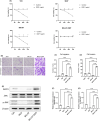Unveiling the role of RAC3 in the growth and invasion of cisplatin-resistant bladder cancer cells
- PMID: 38847477
- PMCID: PMC11157678
- DOI: 10.1111/jcmm.18473
Unveiling the role of RAC3 in the growth and invasion of cisplatin-resistant bladder cancer cells
Abstract
Bladder cancer is one of the most prevalent cancers worldwide, and its morbidity and mortality rates have been increasing over the years. However, how RAC family small GTPase 3 (RAC3) affects the proliferation, migration and invasion of cisplatin-resistant bladder cancer cells remains unclear. Bioinformatics techniques were used to investigate the expression of RAC3 in bladder cancer tissues. Influences of RAC3 in the grade, stage, distant metastasis, and survival rate of bladder cancer were also examined. Analysis of the relationship between RAC3 expression and the immune microenvironment (TIME), genomic mutations, and stemness index. In normal bladder cancer cells (T24, 5637, and BIU-87) and cisplatin-resistant bladder cancer cells (BIU-87-DDP), the expression of RAC3 was detected separately with Western blotting. Plasmid transfection was used to overexpress or silence the expression of RAC3 in bladder cancer cells resistant to cisplatin (BIU-87-DDP). By adding activators and inhibitors, the activities of the JNK/MAPK signalling pathway were altered. Cell viability, invasion, and its level of apoptosis were measured in vitro using CCK-8, transwell, and flow cytometry. The bioinformatics analyses found RAC3 levels were elevated in bladder cancer tissues and were associated with a poor prognosis in bladder cancer. RAC3 in BIU-87-DDP cells expressed a higher level than normal bladder cancer cells. RAC3 overexpression promoted BIU-87-DDP proliferation. The growth of BIU-87-DDP cells slowed after the knockdown of RAC3, and RAC3 may have had an impact on the activation of the JNK/MAPK pathway.
Keywords: JNK; RAC3; bladder cancer; cisplatin resistance; invasion; proliferation.
© 2024 The Author(s). Journal of Cellular and Molecular Medicine published by Foundation for Cellular and Molecular Medicine and John Wiley & Sons Ltd.
Conflict of interest statement
The authors declare that they have no conflict of interest to disclose.
Figures










Similar articles
-
KLF1 Activates RAC3 to Mediate Fatty Acid Synthesis and Enhance Cisplatin Resistance in Bladder Cancer Cells.Am J Mens Health. 2024 Sep-Oct;18(5):15579883241273305. doi: 10.1177/15579883241273305. Am J Mens Health. 2024. PMID: 39376007 Free PMC article.
-
Gambogic Acid Improves Cisplatin Resistance of Bladder Cancer Cells through the Epithelial-Mesenchymal Transition Pathway Mediated by the miR-205-5p/ZEB1 Axis.Ann Clin Lab Sci. 2024 May;54(3):354-362. Ann Clin Lab Sci. 2024. PMID: 39048172
-
PAX2 mediated upregulation of ESPL1 contributes to cisplatin resistance in bladder cancer through activating the JAK2/STAT3 pathway.Naunyn Schmiedebergs Arch Pharmacol. 2024 Sep;397(9):6889-6901. doi: 10.1007/s00210-024-03061-3. Epub 2024 Apr 4. Naunyn Schmiedebergs Arch Pharmacol. 2024. PMID: 38573552
-
[Impacts of curcumin on proliferation, migration and cisplatin resistance of bladder cancer cells by regulating LKB1-AMPK-LC3 signaling pathway].Xi Bao Yu Fen Zi Mian Yi Xue Za Zhi. 2025 Jan;41(1):9-16. Xi Bao Yu Fen Zi Mian Yi Xue Za Zhi. 2025. PMID: 39799420 Chinese.
-
Forkhead Box R2 Knockdown Decreases Chemoresistance to Cisplatin via MYC Pathway in Bladder Cancer.Med Sci Monit. 2019 Nov 25;25:8928-8939. doi: 10.12659/MSM.917345. Med Sci Monit. 2019. PMID: 31761897 Free PMC article.
Cited by
-
Deciphering the oncogenic role of Rac family small GTPase 3 in hepatocellular carcinoma through multiomics integration.World J Hepatol. 2025 Jul 27;17(7):106151. doi: 10.4254/wjh.v17.i7.106151. World J Hepatol. 2025. PMID: 40747231 Free PMC article.
References
-
- Sung H, Ferlay J, Siegel RL, et al. Global cancer statistics 2020: GLOBOCAN estimates of incidence and mortality worldwide for 36 cancers in 185 countries. CA Cancer J Clin. 2021;71(3):209‐249. - PubMed
-
- Bray F, Ferlay J, Soerjomataram I, Siegel RL, Torre LA, Jemal A. Global cancer statistics 2018: GLOBOCAN estimates of incidence and mortality worldwide for 36 cancers in 185 countries. CA Cancer J Clin. 2018;68(6):394‐424. - PubMed
-
- Witjes JA, Bruins HM, Cathomas R, et al. European Association of Urology Guidelines on muscle‐invasive and metastatic bladder cancer: summary of the 2020 guidelines. Eur Urol. 2021;79(1):82‐104. - PubMed
-
- Li F, Zheng Z, Chen W, et al. Regulation of cisplatin resistance in bladder cancer by epigenetic mechanisms. Drug Resist Updat. 2023;68:100938. - PubMed
MeSH terms
Substances
Grants and funding
LinkOut - more resources
Full Text Sources
Medical
Research Materials
Miscellaneous

